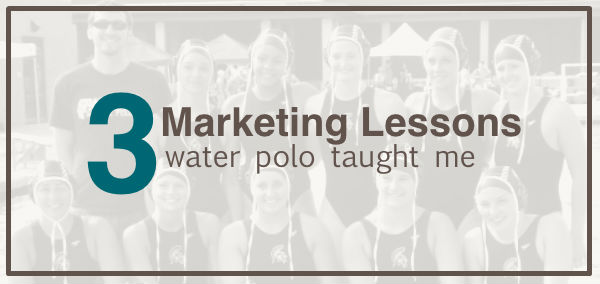You may not know this about me, but in high school I started playing water polo – and for the next fifteen years it was a primary part of my identity.
I played in high school, then at Michigan State, and more casually for nearly another decade.
Somewhere along the way I started coaching co-ed middle school water polo, then women’s high school, and eventually the MSU men’s team.
It shaped not only my network and my daily schedule – but it also my personal values.
Water polo was a game that made sense to me, and to this day it still helps me make sense of the world.
3 Marketing Lessons Water Polo Taught Me
1. Adjust your Message to fit your Audience
Having coached boys and girls, ranging from middle school to college age, I can tell you with complete confidence that your ability to create results is directly tied to your ability to communicate a message.
And here’s the thing that most people miss – it’s not just about how you deliver that message, it’s also about how that message is received.
I quickly learned that the things I did to motivate middle schoolers didn’t work to motivate high school age kids.
The marketers among us know this as segmentation 101 – know your audience, and frame your message accordingly.
How you say something can be just as important as what you say.
2. The Whole is Greater than the Sum of its Parts
One of my philosophies for coaching was to break the season into chunks – and use each chunk to focus on an aspect of the game.
Every game features defense and offense, obviously, but it also features the transition FROM defense to offense, and the transition from offense to defense; and that’s just when both teams are at full strength.
There are also power plays, where a player from one team has been excluded for a major foul, and since that can happen to either team there is power play defense and power play offense.
So when approaching a season – we’d always start with conditioning, because in order to execute any of the strategies we draw up, the athletes need to be in shape.
Then, we’d focus on defense, offense, transition defense, transition offense, and finally power plays (defense and offense).
There are certainly more niche parts of the game, and mid-season adjustments to be made, but at a high level – it’s just those 6 segments.
I think of it this way – it’s like throughout the season we are collecting puzzle pieces.
Every week or two we collect another piece of the puzzle.
And then at the end of the season we’d have all six pieces, and then it’s just a matter of putting them together.
Building a marketing strategy works this way too.
Except the pieces of the puzzle are the stages of lifecycle marketing: Traffic, Lead Capture, Nurture, Conversion, Fulfillment, etc
You can focus on each of those pieces independently, but the results are multiplied once you start to put the pieces together and it forms your cohesive customer journey.
Watch the Video
3. Create a System
During my last two seasons as the women’s head coach at Okemos High School we won back-to-back state championships and had a record of 69 wins and 1 loss.
There is no question that I coached some very talented and capable athletes.
I was fortunate to have great support from my assistant coaches, and from the parents of the athletes, and from the athletic department at our school.
But more than any of those things I attribute our success to the system we built.
Yes, I’m referring to the system that we applied each season to collect, refine, and ultimately assemble those six parts of the game; but I’m also talking about the systems that supported that.
Remember, before coaching high school I spent four years leading the area’s middle school program – so when I started coaching high school a number of the kids had played for me previously.
This meant I not only knew them, but they knew what I expected from them.
They knew when I was joking, or when I was serious, how we structured practice, and how we got ready for games.
But as importantly, I knew what they were coming into high school having already done – I knew the drills they had been running, and the fundamentals they had been taught.
We didn’t start winning overnight, in fact we didn’t even make the state tournament in my first season coaching high school.
But as kids graduated and new players joined the team – our system began to work, our focus crystallized, and we started to win.
The next year we finished 4th in the state.
And then in season three, we swept the table going a perfect 35-0 with five All-State players, two All-Americans, and the state MVP.
Don’t get me wrong, I’m very proud of all that – but what happens next is why I’m telling this story.
After that state championship we graduated 4 of our 7 starting players, as it happened – they were our our 4 leading scorers (combining for 80% of our offense).
But the next season we won again, this time with a record of 34-1.
Like I said, I think these results can be attributed to lots of things – great athletes, terrific assistant coaches, and supportive parents, etc; but the marketer in me looks back on what we did and what I see was a well-oiled machine.
I see a productive middle school program that created kids who loved the sport, and knew the rules, and were ready to compete.
I see an organized high school program with athletes who knew what was expected of them, and showed up every day ready to work.
Without a system losing our top four scorers could have crippled us.
The same is true for your business, for my business, or for any business.
Whether it’s your top performing sales reps, or your highest converting ads, they’re only as good as their last performance; and if they disappear, their results do too – but the system that created these is your safety net.
Systems are by nature predictable, and predictability is what allows businesses to scale, or in our case – teams to thrive.
Design a system that consistently creates the customers you serve best.
You can win individual games on the backs of talented athletes, but long term success comes when you take the time to create the environment that fosters success.
The truth is that I struggled a little writing this post – and I nearly decided not to publish it, because it felt a little too much like me just reliving some glory days.
I chose to share it because the lessons are real; and have only become clearer over time.
I guess what I’m saying is that these lessons happened long before I recognized their marketing relevance, and that periodically revisiting experiences (and accomplishments) of ours can not only be cathartic, but for me it’s revealing angles I hadn’t previously noticed.
If you found this valuable, or you’ve had hidden lessens emerge while you wax nostalgic on something – let me know in the comments below.










Great post! Thanks for sharing!!
Thanks Gina! I appreciate you reading and taking the time to comment. 🙂
I love this post, Greg. Star athletes are like great sales reps – they produce amazing results, but they can disappear, and you better have a winning system in place. I’m currently experiencing the consequences of insufficient customer nurture (or “wow”). A few clients are not renewing their subscription, and it’s because I dropped the ball. A reliable, predicable system could have mitigated this problem, but I was building other puzzle pieces. We’ll call this my season 1. 🙂
That’s the thing though, it’s not about perfection, it’s about progress. Just keep getting better.
Great message, thanks for being venerable and sharing! Balance is key in EVERY aspect of life! Thanks for the reminder!
My pleasure! Thanks for reading. 🙂